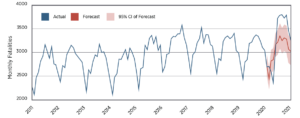
Traffic Safety Impact of the COVID-19 Pandemic: Fatal Crashes Relative to Pre-Pandemic Trends, United States, May–December 2020
The number of traffic fatalities increased significantly in the United States during the COVID-19 pandemic. This Research Brief identifies crash-, vehicle-, and driver-related factors that contributed most to the increase in traffic fatalities.
December 2022
Suggested Citation
Abstract
Introduction
Despite a brief reduction during the initial months of the COVID-19 pandemic, the number of people killed in motor vehicle crashes in the United States surged in 2020 to its highest level in over a decade. The purpose of the research reported here is to advance the understanding of how safety on U.S. roads changed during the pandemic, beyond its initial months, by comparing the involvement of specific crash-, vehicle-, and driver-related factors in fatal crashes during the eight-month period of May through December 2020 to what would have been expected had the pandemic not occurred and pre-pandemic trends continued. Data from all fatal crashes in the U.S. from 2011 through 2019 were used to develop statistical models of the monthly number of fatal crashes through December 2019. These models were then used to forecast how many fatal crashes would been expected in each month of 2020 without the pandemic. Overall, the number of traffic fatalities in 2020 was 2,570 (7.1%) more than expected based on pre-pandemic trends. However, a sharp decrease in traffic fatalities in March and April 2020 partially offset an even larger increase later in the year. During the eight-month period of May through December 2020, the number of traffic fatalities was 3,083 (12.1%) more than expected. Importantly, however, this increase was not uniform across all factors examined. This Research Brief identifies specific crash-, vehicle-, and driver-related factors that contributed most to the overall increase in traffic fatalities during this period, as well as others that continued to follow pre-pandemic trends or that even decreased.
Key Findings
A total of 38,824 people died in motor vehicle crashes in the U.S. in 2020, 2,570 (7.1%) more than forecast from models developed using data from 2011 through 2019 (Figure). In April 2020—the first full month of the pandemic—the number of fatalities was much lower than what would have been expected based on pre-pandemic trends. By May 2020, however, the actual number of fatalities was similar to historical levels. The number of fatalities greatly exceeded forecasts based on pre-pandemic trends for the remainder of 2020. In May through December collectively, there were a total of 28,611 traffic fatalities nationwide, which was 3,083 (12.1%) more than expected based on pre-pandemic trends.

The increase in traffic fatalities was not uniform across crash-, vehicle-, and driver-related factors. Scenarios present in greater than expected numbers in fatal crashes in 2020 included evening and late-night hours, speeding drivers, drivers with illegal alcohol levels, drivers without valid licenses, drivers of older vehicles, drivers of vehicles registered to other people, crash involvement and deaths of teens and young adults, and deaths of vehicle occupants not wearing seatbelts. In contrast, several crash types followed pre-pandemic trends (e.g., crashes in the middle of the day; crash involvements of drivers with valid licenses; pedestrian fatalities), and a few decreased (e.g., crashes of elderly drivers; crashes during typical morning commute hours).
Methodology
The purpose of this study was to examine the involvement of particular crash, vehicle, driver, and behavioral factors in fatal motor vehicle crashes during the COVID-19 pandemic relative to what would have been expected based on recent pre-pandemic trends. Because traffic safety during the initial months of the pandemic has been studied extensively, and because the year-over-year increase in the absolute number of traffic fatalities began in or around May 2020, the current study focused on the period of May through December 2020.
The study examined data on all crashes that occurred on public roads in the United States in years 2011–2020 and resulted in at least one death. The number of fatal crashes in each month of years 2011–2019 was modelled using a Seasonal Autoregressive Integrated Moving Average model. The model was then used to forecast the number of fatal crashes that would have been expected in each month of 2020, without the pandemic, based on pre-pandemic trends. The actual number of fatal crashes that occurred in each month of 2020 was then compared to the corresponding forecast. The difference between the actual number of fatal crashes versus the forecast was considered statistically significant if the actual number fell outside of the 95% confidence interval of the corresponding forecast. Separate models and forecasts were developed for each crash-, vehicle-, and driver-related factor examined.
Suggested Citation